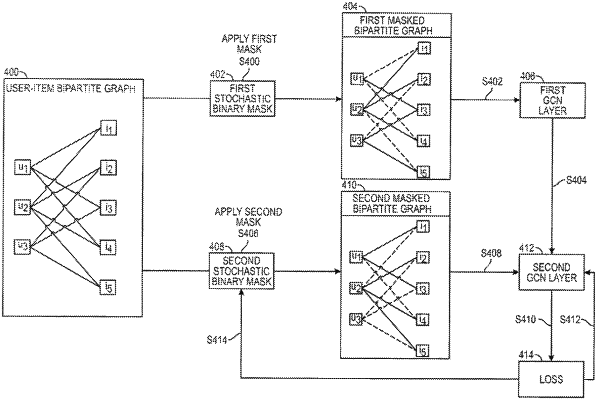| CPC G06N 3/0464 (2023.01) [G06N 3/047 (2023.01); G06Q 30/0282 (2013.01); G06Q 30/0631 (2013.01)] | 20 Claims |

|
1. A method comprising:
receiving a first dataset comprising a plurality of embeddings of a first type and of a second type, the embeddings of the first type associated with a first node type and the embeddings of the second type associated with a second node type;
generating a fixed adjacency matrix from the first dataset;
applying a first stochastic binary mask to the fixed adjacency matrix to obtain a first subgraph of the fixed adjacency matrix;
processing the first subgraph of the fixed adjacency matrix through a first layer of a graph convolutional network to obtain a first embedding matrix;
applying a second stochastic binary mask to the fixed adjacency matrix to obtain a second subgraph of the fixed adjacency matrix;
processing the first embedding matrix and the second subgraph of the fixed adjacency matrix through a second layer of the graph convolutional network to obtain a second embedding matrix;
determining a plurality of gradients of a loss function;
modifying the first stochastic binary mask and the second stochastic binary mask using at least one of the plurality of gradients;
generating a second fixed adjacency matrix from a second dataset;
applying the modified first stochastic binary mask to the second fixed adjacency matrix to obtain a third subgraph of the second fixed adjacency matrix;
processing the third subgraph of the second fixed adjacency matrix through the first layer of the graph convolutional network to obtain a third embedding matrix associated with the second dataset;
applying the modified second stochastic binary mask to the second fixed adjacency matrix to obtain a fourth subgraph of the second fixed adjacency matrix;
processing the third embedding matrix associated with the second dataset and the fourth subgraph of the second fixed adjacency matrix through the second layer of the graph convolutional network to obtain a fourth embedding matrix associated with the second dataset; and
generating a recommendation score between an embedding of the first type and an embedding of the second type from the second dataset, using at least the third embedding matrix and the fourth embedding matrix associated with the second dataset.
|